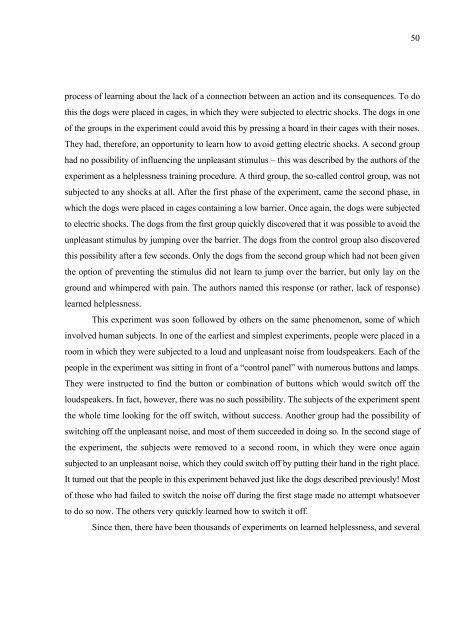PSYCHOMANIPULATION - Tomasz Witkowski
PSYCHOMANIPULATION - Tomasz Witkowski
PSYCHOMANIPULATION - Tomasz Witkowski
Create successful ePaper yourself
Turn your PDF publications into a flip-book with our unique Google optimized e-Paper software.
process of learning about the lack of a connection between an action and its consequences. To do<br />
this the dogs were placed in cages, in which they were subjected to electric shocks. The dogs in one<br />
of the groups in the experiment could avoid this by pressing a board in their cages with their noses.<br />
They had, therefore, an opportunity to learn how to avoid getting electric shocks. A second group<br />
had no possibility of influencing the unpleasant stimulus – this was described by the authors of the<br />
experiment as a helplessness training procedure. A third group, the so-called control group, was not<br />
subjected to any shocks at all. After the first phase of the experiment, came the second phase, in<br />
which the dogs were placed in cages containing a low barrier. Once again, the dogs were subjected<br />
to electric shocks. The dogs from the first group quickly discovered that it was possible to avoid the<br />
unpleasant stimulus by jumping over the barrier. The dogs from the control group also discovered<br />
this possibility after a few seconds. Only the dogs from the second group which had not been given<br />
the option of preventing the stimulus did not learn to jump over the barrier, but only lay on the<br />
ground and whimpered with pain. The authors named this response (or rather, lack of response)<br />
learned helplessness.<br />
This experiment was soon followed by others on the same phenomenon, some of which<br />
involved human subjects. In one of the earliest and simplest experiments, people were placed in a<br />
room in which they were subjected to a loud and unpleasant noise from loudspeakers. Each of the<br />
people in the experiment was sitting in front of a “control panel” with numerous buttons and lamps.<br />
They were instructed to find the button or combination of buttons which would switch off the<br />
loudspeakers. In fact, however, there was no such possibility. The subjects of the experiment spent<br />
the whole time looking for the off switch, without success. Another group had the possibility of<br />
switching off the unpleasant noise, and most of them succeeded in doing so. In the second stage of<br />
the experiment, the subjects were removed to a second room, in which they were once again<br />
subjected to an unpleasant noise, which they could switch off by putting their hand in the right place.<br />
It turned out that the people in this experiment behaved just like the dogs described previously! Most<br />
of those who had failed to switch the noise off during the first stage made no attempt whatsoever<br />
to do so now. The others very quickly learned how to switch it off.<br />
Since then, there have been thousands of experiments on learned helplessness, and several<br />
50


